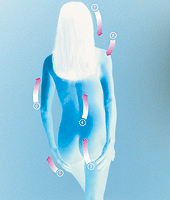Give Your Skin the Brush Off!
Beautiful skin reflects our overall health and general well-being--and rightly so. The skin is the largest organ of the human body, renewing some of its cells every 24 hours.

Wearing synthetic fabrics and following a sedentary lifestyle can play havoc with the skin's natural functions, leaving it in less-than-optimal conditions. Aging is another factor, as skin functions tend to become less efficient as we grow older. To help maintain the smooth, healthy look of youthful skin, one answer is dry-brushing, an ages-old form of self-massage.
Dry-brushing conditions the skin by sloughing off dead cells and keeping the pores open, helping to prevent ingrown hairs and stimulating lymphatic drainage, which removes toxins such as uric acid crystals and catarrh. (Poor lymphatic drainage has been linked to hypertension, arthritis, depression and other conditions.) Dry-brushing improves circulation, stimulates hormone function, rejuvenates the nervous system, enhances immune function and contributes to better muscle tone and fat distribution within body tissues, making it an excellent treatment for cellulite and fluid-retention problems. It is effective for boosting energy levels and relieving sore muscles. The practice of dry-brushing is even said to be as good for the body as 20 minutes of jogging, though it is not recommended as a substitute for exercise.
How to Dry-Brush
An inexpensive practice, dry-brushing can be done by almost anyone. All you need is a natural-bristle body brush or mitt. Avoid using synthetic fibres they are too harsh and may actually damage the skin. Hemp, jute, sisal and loofah are suitable substances, though some people switch to coconut fibre once their skin has become accustomed to brushing because it affords a more stimulating massage. Increasing the pressure you use with any of the other fibres mentioned works just as well. A long-handled or double-handled brush will enable you to access those hard-to-reach back areas. Most of these brushes and mitts are available at your local health food store at reasonable prices.
Dry-brushing is best done before a bath or shower, morning or evening. Starting with the soles of your feet, begin gently brushing in a circular motion, always moving toward the heart. Move up your legs, front and back, paying extra attention to the front of your knees. Next brush buttocks, hips and lower abdomen, massaging from right to left, chest (avoid nipples) up to the base of your neck and your back. Then brush from your fingertips to your shoulders, paying extra attention to your outer elbows. Use a good quality, dry face cloth or a soft complexion or shaving brush to gently massage your neck and face. The entire procedure usually takes between five and 10 minutes. If you are dry-brushing as a cellulite treatment, repeat the entire treatment. Brush off your brush or shake out your mitt over the tub. Now you are ready for a bath or shower.
To invigorate, have a hot bath or shower; for relaxation, have one that is warm. It is advisable to have a cool shower after a hot bath or shower. This further enhances the stimulating effects of dry-brushing. A brisk rub-down with your towel also helps remove dead cells and promote circulation.
To nourish the skin and enhance relaxation, you may want to finish with a light vegetable-oil massage: sweet almond, apricot kernel, sunflower and jojoba oils are some favourites. Add seven drops of therapeutic-grade lavender, frankincense or rose essential oil to 15 millilitres of your choice of a vegetable-oil carrier. For children, the convalescing and the aged, add three drops to 15 ml of carrier oil. Massage into the skin immediately following the bath or shower. Vary your essential oil choices for maximum benefit and to prevent sensitization. Avoid using mineral oil; it robs the skin of important nutrients. Almond oil is one of the most skin-friendly massage oils.
Dry-Brushing Tips
If you are using this technique as part of a detoxification program, dry-brush daily. don't worry if after your first week or so you notice the appearance of small pimples or bumps. This indicates your skin is increasing its capacity to eliminate toxins. Keep dry-brushing and soon your skin will become clearer and healthier.
Each month, take a week's break from dry-brushing, especially if you're brushing daily. This keeps the body from becoming overly habituated to the practice, ensuring
maximum benefit from it during your active periods.
Never share your brush; each family member should have her or his own. Wash your brush or mitt every couple of weeks in warm water using a mild soap and hang it to dry in an area that allows air circulation on all sides to prevent the growth of mildew.
Dry-brushing, drinking enough water (eight to 10 glasses daily) and getting adequate sleep and exercise can help you maintain beautiful, healthy skin for life.




